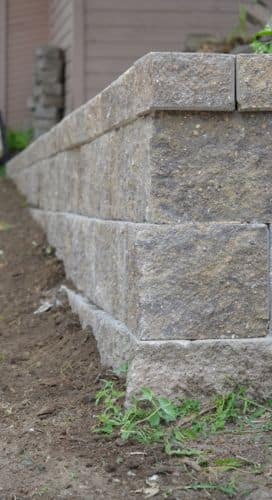Segmental Retaining Wall
A segmental retaining wall (SRW) can better be explained as a gravity wall which consists of several courses of structural block units. This type of wall is best served in areas where a harsh freeze thaw cycle occurs on a yearly basis. Other forms of retaining walls are available such as pilling walls, cantilever walls, and anchor walls. All of which have their benefits and shortcomings.
View photos of retaining walls we’ve installed. We’ve also created a photo gallery on How to Build a Retaining Wall.

One of the other main benefits of a SRW verses cement or pour walls is they are modular and have minor tolerance for movement during the freeze thaw cycle. During this cycle the expansion of moisture in the ground and within some parts of walls places large amounts of pressure on the wall. Which a poured wall this can lead to severing or breaking of the concrete because it is a rigid singular structure. Where as a SRW will allow for slight movement (1/4”) during this process and ensure greater stability. Because they do not require a rigid concrete footing they better maintain their structure in these harsh frost areas.
On top of the structural benefits to a SRW they also offer a much more aesthetically pleasing appearance. With a split rock face the walls units are advancing to look more and more like natural stone. Manufactures have even begun using blended colors in the production process to match their setting more accurately.
Anchor wall systems has developed the Highland 6” wall units which allow for a very natural yet structurally sound system, as seen in our Ultimate Back Yard Challenge project in 2008 and 2010. In more recent years they have developed other styles of blocks such as the Artisana retaining wall system and the Brisa 6”/3” retaining wall system. Our local manufacturer of Anchor wall systems is Watkins Concrete Block Company; which we are a preferred contractor for.
We compiled a list of links if you are looking for retaining wall ideas and inspiration.
Freestanding or Seat Walls
Highland Freestanding or seat walls have been developed in the last ten years as a decorative but structurally sound method of creating permanent seating. They have grown to include pillars and pilasters which allow of natural stone caps as well as lighting to modify the ambiance of the area. A freestanding wall can create privacy, decorate an area and provide seating which blends highland retaining walls freestanding walls.
NCMA

To assure quality we are certified by the Nebraska Concrete and Masonry Association (NCMA). The Nebraska Concrete Masonry Association is an association insures the quality use of masonry materials, technical data, the advantages and many uses of masonry, designs and codes for the residential and commercial construction markets in the State of Nebraska. Customers should be leery of contractors who do not carry this certification can and have produced structurally unsound walls. Products such as Anchors Diamond Pro and Vertica Pro retaining wall units are designed to be the most structurally sound product on the market. They have been used on many large projects and will continue to last for many years.
What is the cost of a custom retaining wall?
The price of a retaining wall is determined by several factors (type of block, size, etc). We are happy to provide a free consultation and quote.
We also offer boulder and rock installation.
